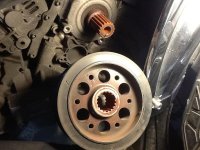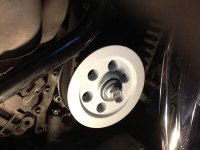Just wanted to put this out there.
1. Just because you have red dust doesn't mean your sprocket is bad.
2. Just because you don't have red dust doesn't mean your sprocket is good.
My sprocket looked like new. No red dust but it failed inspection. I only have 9700 miles on my F3. A new sprocket was installed on it today. Now we are ready for our trip to Sturgis.
Unfortunately, you have not defined your interpretation of bad. Any indication of red dust is an indication of wear. Granted the interim inspection criteria does not mandate inspecting for wear on cleaned splines, which would indicate an accurate wear dimension. Residual fretted particles are allowed in the spline joint, possibly altering the true wear dimension.
More correctly, some owners having the interim inspection accomplished have had red dust and the tech determined the amount of wear was acceptable at this time, no further action was taken except to reinstall the bolt. Other owners having the interim inspection accomplished also noted red dust, and the tech found the wear beyond limits.
The interim inspection is just that, the pulley is still deemed bad, to use your word, as it will be dealt with again in a short interval (hopefully). Passing the interim inspection does not mean the pulley is good, simply it passed a wear check at this time.
Red dust is an indicator of fretting, fretting is wear, without corrective actions, fretting will continue until complete failure occurs. Fretting, like other corrosion does not self heal.
The interim inspection may prove to be a false sense of security, interpreted as the pulley is good, and the owner fails to return for the true method of correction to the issue.
Sadly, having a pulley pass the interim inspection is worse than having it fail. When failed, the pulley is removed, the hard oxide particles from fretting that abrade the components are cleaned away. A new replacement pulley is installed, hopefully lubricated (at a minimum with the Kluber Paste that is expensive, on backorder, and has no longevity) on reinstallation.
The hard oxide particles produced from the fretting corrosion is the ultimate enemy. Oxides are what grinding discs and sandpaper use for grit. The interim inspection does not remove this. Replacing the pulley does.
Simply sharing. And yes, with a decade of teaching corrosion control on aircraft plus years of experience repairing all forms of corrosion on aircraft, I may not have stayed in a Holiday Inn Express last night, but I do have a solid background on the corrosion topic and decades of experience working with spline drives, including visual inspections, wear inspections, and clean / relube checks. All the best to anyone having a pulley inspection accomplished at the dealer. If capable, I endorse at a minimum, remove the pulley, clean and inspect the splines on the gearbox shaft and pulley bore for wear. Visually, the pulleys outboard end will have virgin splines. This can serve as a visual wear indicator. There has been much discussion regarding which lubricant is best. In 2017 I inspected and reassembled our 2014 using a Bel Ray moly paste.
Again, all the best, however you proceed.
PLease PM me if it doesn't...
hyea:


